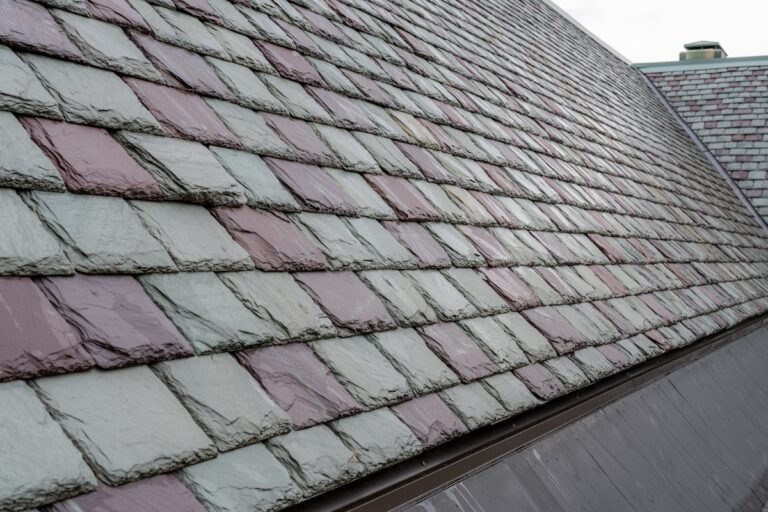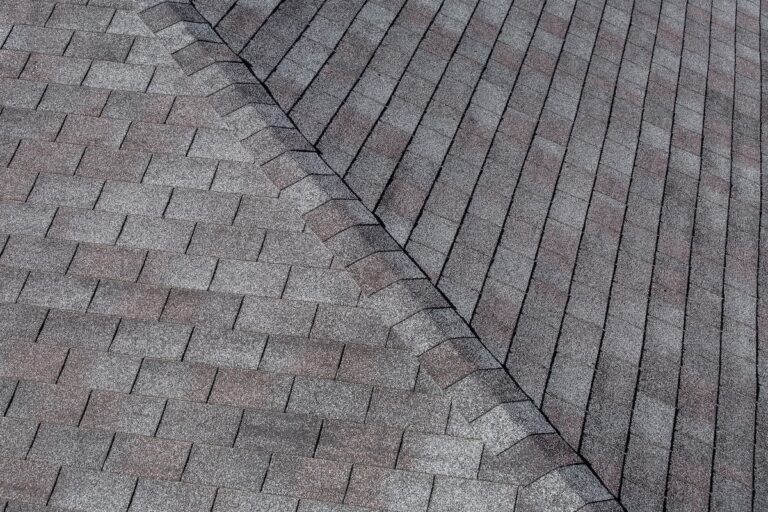Shingles have been a staple in roofing for centuries, providing homes with protection from the elements and a distinctive aesthetic appeal. But have you ever found yourself wondering “what are shingles made of?”
Understanding their composition can give you greater insight into their durability, functionality, and why certain types of shingles are more suitable for specific climates or architectural styles. In this comprehensive guide, we’ll explore:
- The different materials used in shingle manufacturing
- Their benefits
- Common drawbacks
Types of Shingles
Before we dive into the specifics of what shingles are made of, it’s essential to understand that there are various types of shingles, each made from different materials. The most common types include:
- Asphalt Shingles
- Wood Shingles
- Metal Shingles
- Slate Shingles
- Tile Shingles
- Composite Shingles
Each type comes with its own set of advantages and disadvantages, so let’s take a closer look at each one.
All About Asphalt Shingles
Asphalt roofing shingles are the most popular roofing material in the United States, primarily due to their affordability and versatility. They are composed of three main layers:
1) Fiberglass or Organic Mat:
- Fiberglass Mat: This provides the structural support for the shingle. Fiberglass mats are made by weaving glass fibers together, which makes them strong yet lightweight.
- Organic Mat: This is an older type of mat made from cellulose fibers derived from wood, paper, and other organic materials. Though less common today, organic mats are still used in some regions.
2) Asphalt Coating:
The mat is coated with asphalt to make it waterproof. This layer also adds weight to the shingle, helping it adhere better to the roof.
3) Mineral Granules:
The top layer consists of mineral granules that provide UV protection, add color, and offer additional weight to help the shingle lay flat.
Benefits and Drawbacks
- Benefits:
- Cost-effective
- Easy to install
- Available in various colors and styles
- Good fire resistance
- Drawbacks:
- Shorter lifespan compared to other materials
- Susceptible to wind and hail damage
- Not as environmentally friendly
The Facts About Wood Roofing Shingles
Wood shingles, also known as shakes, are made from natural wood, typically cedar, redwood, or pine. The wood is cut into thin, tapered pieces, which are then treated to improve their resistance to fire, insects, and rot.
Benefits and Drawbacks
- Benefits:
- Natural and rustic appearance
- Good insulation properties
- Environmentally friendly if sourced sustainably
- Drawbacks:
- High maintenance
- Susceptible to fire and insect damage
- Expensive
Learn About Metal Shingles
Metal shingles are made from various metals, including aluminum, steel, copper, and zinc. They are coated with a protective layer to prevent rust and corrosion and can be designed to mimic the appearance of other materials, such as wood or slate.
Benefits and Drawbacks
- Benefits:
- Durable and long-lasting
- Lightweight
- Fire-resistant
- Reflects heat, improving energy efficiency
- Drawbacks:
- Expensive
- Can be noisy during rain or hail
- Susceptible to denting
The Secrets of Slate Shingles
Slate shingles are made from natural slate rock, which is cut into thin, flat pieces. This material is incredibly durable and has been used in roofing for centuries.
Benefits and Drawbacks
- Benefits:
- Extremely durable and long-lasting
- Natural and elegant appearance
- Fire-resistant
- Drawbacks:
- Very heavy, requiring additional structural support
- Expensive
- Difficult to install and repair
Talking About Tile Shingles
Tile shingles are made from natural clay or concrete, which is molded into shape and then baked at high temperatures. They can be glazed for added color and protection.
Benefits and Drawbacks
- Benefits:
- Long-lasting and durable
- Excellent fire resistance
- Available in various colors and styles
- Drawbacks:
- Heavy, requiring additional structural support
- Expensive
- Brittle, making them susceptible to breaking
Composite Shingle Guide
Composite shingles are made from a blend of materials, including recycled paper, plastic, and asphalt. They are designed to mimic the appearance of more expensive materials like wood or slate.
Benefits and Drawbacks
- Benefits:
- Versatile and available in various styles
- More affordable than natural materials
- Durable and low maintenance
- Drawbacks:
- Not as long-lasting as natural materials
- Can fade over time
- May not have the same aesthetic appeal as natural materials
Choosing the Right Shingle for Your Roof
When selecting the right shingles for your roof, several factors need to be considered:
Climate
The climate in your area plays a significant role in determining the best type of shingles for your roof. For example:
- Hot Climates: Metal and tile shingles are excellent choices for hot climates as they reflect sunlight and reduce heat absorption.
- Cold Climates: Asphalt and wood shingles are suitable for colder climates as they provide good insulation and can withstand freezing temperatures.
- Windy Areas: Metal and slate shingles are ideal for areas prone to high winds as they are durable and resistant to wind damage.
Budget
Your budget will also influence your choice of shingles. While asphalt shingles are the most cost-effective option, they may not last as long as more expensive materials like slate or tile. It’s essential to balance the initial cost with the long-term benefits and maintenance requirements.
Aesthetic Appeal
The appearance of your shingles can significantly impact the overall look of your home. Consider the following:
- Traditional Homes: Wood and slate shingles are ideal for traditional or historic homes, providing a timeless and classic look.
- Modern Homes: Metal and composite shingles work well for modern homes, offering a sleek and contemporary appearance.
- Mediterranean or Spanish-Style Homes: Tile shingles are perfect for Mediterranean or Spanish-style homes, complementing their architectural style.
Environmental Impact
If you’re concerned about the environmental impact of your roofing materials, consider the following options:
- Recycled Materials: Composite shingles made from recycled materials are an eco-friendly choice.
- Sustainably Sourced Wood: Wood shingles sourced from sustainable forests are another environmentally friendly option.
- Metal Shingles: Metal shingles are recyclable at the end of their lifespan, reducing their environmental impact.
Installation and Maintenance
Proper installation and maintenance are crucial for the longevity and performance of your shingles. Here are some tips:
- Hire a Professional: Always hire a licensed and experienced roofing contractor to install your shingles. Proper installation ensures the best performance and reduces the risk of future issues.
- Follow Manufacturer Guidelines: Make sure your contractor follows the manufacturer’s guidelines for installation. This includes using the recommended underlayment, fasteners, and ventilation systems.
- Inspect Your Roof Deck: Before installing new shingles, inspect your roof deck for any damage or rot. Repair or replace any damaged areas to ensure a solid foundation for your new shingles.
- Regular Inspections: Conduct regular roof inspections, especially after severe weather events. Look for signs of damage, such as missing, cracked, or curling shingles.
- Clean Gutters: Keep your gutters clean and free of debris to prevent water buildup and potential damage to your shingles.
- Trim Overhanging Branches: Trim any overhanging tree branches to prevent them from rubbing against your shingles and causing damage.
- Address Issues Promptly: If you notice any problems with your shingles, address them promptly to prevent further damage and costly repairs.
Roof Shingles Made Simple
Understanding what shingles are made of and the benefits and drawbacks of each material can help you make an informed decision for your roofing project. Whether you choose asphalt, wood, metal, slate, tile, or composite shingles, each type offers unique advantages and can enhance the beauty and functionality of your home.
Whether you think an asphalt shingle roof is right for you, or are looking into tile and composite roofing, Johnson Restoration can help you with all of your roof replacement needs. Contact us today to learn more!






